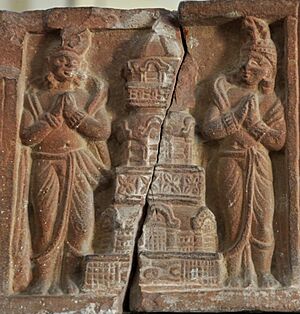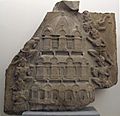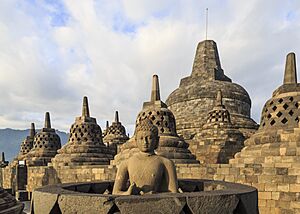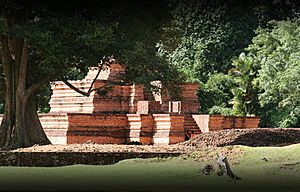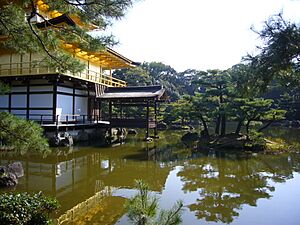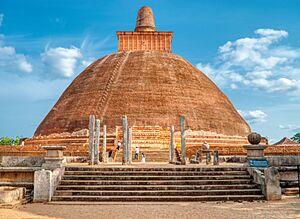Buddhist temple facts for kids
|
Basic terms |
|
|
People |
|
|
Schools |
|
|
Practices |
|
|
study Dharma |
|
A Buddhist temple is a special place of worship for Buddhists. These temples can be called different names like vihara, chaitya, stupa, wat, or pagoda. Buddhist temples are designed to help people find peace inside and out. They represent a pure and peaceful place, like the environment of a Buddha.
Contents
Buddhist Temple Architecture
Buddhist temples have different designs depending on where they are in the world. But they usually include not just the buildings, but also the area around them. Many Buddhist temples are designed to represent five important elements: fire, air, water, earth, and space.
Temples in India
In India, the design of temples was often based on the idea that a place of worship should represent the whole universe. For Buddhist temples, there is often one tall main temple in the center. This main temple is then surrounded by smaller temples and walls. This layout shows the center of the universe, surrounded by oceans, smaller mountains, and a huge wall.
A Chaitya (pronounced "chai-tya") is a type of Buddhist shrine or prayer hall. It often has a stupa inside, which is a dome-shaped structure. Many early Chaityas were carved right into rock, like the famous Karla caves or Ajanta.
Some of the first free-standing temples in India might have been round. For example, Ashoka built the Mahabodhi Temple in Bodh Gaya around 250 BCE. This was a circular building made to protect the Bodhi tree. This is the tree under which the Buddha found enlightenment. You can still see pictures of these early round temples in old carvings, like those at Bharhut and Sanchi.
-
Ashoka's Mahabodhi Temple and Diamond throne in Bodh Gaya, built around 250 BCE. This is from a Bharhut carving.
-
What's left of a circular rock-carved Chaitya with columns at Tulja Caves.
Temples in Indonesia
Buddhism arrived in Indonesia from India a very long time ago, around the 2nd century. Many powerful empires in Indonesia were influenced by Indian culture, including Buddhism. The oldest Buddhist site in Indonesia is thought to be the Batujaya stupas complex in West Java. Some parts of it are from the 2nd century!
Over the centuries, great Buddhist empires rose and fell in Indonesia. These included the Sailendra dynasty and the Srivijaya empire. A Chinese Buddhist monk named I-tsing visited Sumatra in the 7th century. He saw the powerful maritime empire of Srivijaya there.
Indonesia has many amazing Buddhist historical sites. The most famous is the 8th-century Borobudur monument in Central Java. It is the largest Buddhist temple in the world. Other important sites include Sewu temple, Batujaya, and Muaro Jambi.
During the time of the Majapahit empire, Buddhism was one of the official religions, along with Hinduism. People tried to live together peacefully, and sometimes even combined ideas from both religions. This idea is captured in Indonesia's national motto, "Bhinneka Tunggal Ika," which means "Unity in Diversity." This motto encourages tolerance between Hindus and Buddhists.
Today, in Indonesia, the word Candi can mean any shrine, old or new. Some modern Buddhist temples in Indonesia even have copies of famous old temples inside them. A candi often acts like a stupa, which is a dome-shaped building. Stupas are used to store Buddhist relics or the ashes of important Buddhist people.
Temples in Japan
Japanese Buddhist temples usually have a Main Hall. A special part of Japanese temples is the chinjusha. This is a Shinto shrine built for the temple's local spirit or kami. Buddhism and Shinto have co-existed in Japan for a long time. In the 8th century, Buddhism even became the state religion. Many important Japanese Buddhist temples are found in the Kansai region, especially in Nara and Kyoto.
Temples in Thailand
Buddhist temples in Thailand are called wat. The word "wat" comes from an old language and means "enclosure." A wat usually has two main parts. The Phutthawat is the area dedicated to the Buddha. The Sangkhawat is the area for the Sangha, which is the Buddhist monastic community (the monks and nuns).
Temples in Sri Lanka
Buddhist temples in Sri Lanka are called 'Pansala' or 'Viharaya' in the Sinhalese language. Common features in Sri Lankan temples include a Stupa, a Bo Tree, and temple buildings. Sri Lanka is home to the Jaya Sri Maha Bodhi, which is the oldest living human-planted Bodhi Tree in the world. It also has some of the largest Stupas in the world, like Ruwanwelisaya, Jetavanaramaya, and Abhayagiri vihāra.
See also
- Gautama Buddha
- Dambana
- Dhamma
- Sangha
- Three Refuges
- Five Precepts
- Pāli Canon
- Uposatha
- Cetiya
- Sri Maha Bodhi
- Vihara
- Wat
- Kyaung
- Burmese pagoda
- List of Buddhist temples
- Buddhist architecture
- Aniconism in Buddhism




